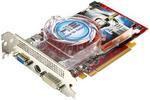Choosing a new graphics or video card can be daunting, with so many products and decisions to make. Should you go for the card with more memory? How do you tell which one is better than the next?


The product ranges produced by various makers all use a graphics chip from either ATI or NVida. To make deciding easier you can normally separate the various options into one of three categories:
Top End / Heavy Graphics / Game Usage - High specification cards with plenty of memory and fast processors providing plenty of power for games or other intensive applications. These cards often include extras such as TV/Video In/Out, DVI connectors, support for several monitor display.

Mainstream / Occasional Gamer - General applications and some gaming. If your system is fairly recent you may not need to change your card. However some of the newer games do require more powerful specifications. For guidance you should view the minimum specifications on the back of the game. Most cards include S-Video, TV Out connectors as standard.

Value Cards - Ideal for general Office and Internet applications. Running graphic intensive games are unlikely to run at a useable rate with these cards as the processor and memory is not rated enough for those tasks.
How to tell if you need a new video card.The obvious way to tell if your current card is up to running your latest game is to try it out. If the graphic detail is poor and sequences become jerky or freeze it most likely the card. However it could be a driver problem, to eliminate this you should try updating your cards drivers via the manufacturer's site. Next view the video settings in the game and try lowering the detail.
If the above does not improve the game then you should look at upgrading your card.
Other factors including RAM and overall system speed can also restrict the amount of games you can run on your system.
Different Card Types
Video cards come in three different connector types: PCI, AGP, and PCI Express. The slots all look different and are easily identifiable from each other.
PCI these connect into the often white slots of your Motherboard, they have been common on motherboards since the early 1990's they replaced the ISA standard.
AGP Often brown connectors were introduced as they allowed four times the bandwidth over PCI. Most AGP video cards are now designed to work only with the newer AGP 2.0 and 3.0 standards.
PCI Express often shortened to PCIe is the latest technology designed to replace AGP and work with the main board systems to allow larger amounts of bandwidth to be transferred which results in a new level of graphics and system performance.
Other connectors
Many video cards now include various additional output connectors some also include Digital TV tuners and allow for cable and other video inputs to be relayed through your system. The most common connectors are defined below.
DB-15 VGA/SVGA connector commonly used for standard output to an analog monitor
S-Video output allows you to connect your PC to a TV or VCR to output the same display as on the screen.
DVI connector typically used to connect digital flat screen monitors. The three different types are DVI-D (Digital), DVI-A (Analog), DVI-I (Integrated Digital/Analog).
Dual monitor support refers to splitting your video signal to go across two monitors instead of one. This can be useful for designers, engineers, and others who prefer to view large files on and still have other windows open. Often the dual monitor support consists of one standard VGA output and one DVI connector, which provides a higher-resolution output used for newer high-end monitors.
Source: www.pchardware.co.uk






No comments:
Post a Comment